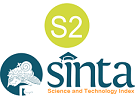Analysis of Students' Cognitive and Affective Ability in the FliCKu Learning Model Based on Bloom's Taxonomy
Abstract
Entering the New Normal era, educators think hard about how new steps or new methods should be taken in learning activities. The teacher hopes that in this new normal era, student learning achievement can increase and there is synchronization during online and offline learning. In order to meet the teacher's expectations, the researcher offers the Flipped Classroom learning model combined with the Kumon learning model, which in this study is called FliCKu. The aims of this study are (1). To find out the FliCKu learning model can improve students' abilities in the cognitive and affective aspects of students. (2). To determine the increase in students' cognitive abilities based on Bloom's taxonomy. The research method used is the mix method with a sample of 22 students. The result of this study is that the FliCku learning model can improve students' cognitive and affective aspects. From the results of the analysis of increasing students' cognitive abilities based on Bloom's taxonomy, at the cognitive level C1 shows students are in the very high category. At the cognitive level C2 shows students are in the very high category. At the C3 cognitive level, it shows that students are in the high category. At the C4 cognitive level, it shows that students are in the medium category. At the cognitive level of C5, it shows that students are in the low category.
Keywords
Full Text:
PDFReferences
Bishop, & J.Verleger. (2013). The Flipped Classroom: A Survey of The Research. Atlanta: 120th ASEE Anual Conference & Exposition.
Creswell, J. W. (2006). Research Design : Qualitative, Quantitative, and Mix Methods Approaches. Los Angles: Sage.
Dhiniaty, Hadna, Henry, & Martono. (2021). Dampak Pembelajaran Daring Terhadap Kemampuan Anak Usia Sekolah Dasar. Jurnal Pendidikan Dasar Nusantara, 100-118.
Dian, W. V. (2021). Model Pembelajaran Kumon untuk Meningkatkan Prestasi Belajar Siswa. Magnetic: Research Journal Of Physics and It’s Application, 81-86.
Hake, R. (1999). Analyzing Change Gain Score. Indiana: Indiana University.
Hartati, Husaini, & Zulfan. (2019). PELAKSANAAN MODEL PEMBELAJARAN KUMON DALAM MENINGKATKAN PRESTASI BELAJAR SEJARAH SISWA KELAS XI IPS SMA NEGERI 1 SAKTI. Jurnal Ilmiah Mahasiswa (JIM) Pendidikan Sejarah FKIP Unsyiah, 26-38.
Ihsana, U. (2017). Pengaruh Kemampuan Afektif, Persepsi Siswa Terhadap Kompetensi Pedagogik Guru dan Kemandirian Belajar Terhadap Prestasi Belajar Bahasa Arab Kelas XI MAN Klaten. Yogyakarta: Fakultas Ilmu Tarbiyah dan Keguruan UIN Sunan Kalijaga.
Irna, Toto, & Laksmi. (2017). EFEKTIVITAS PENERAPAN MODEL PEMBELAJARAN FLIPPED CLASSROOM PADA PENINGKATAN KEMAMPUAN BERPIKIR KRITIS SISWA. EDUTCEHNOLOGIA, Vol 3. No 2.
Junaidi. (2017). ANALISIS KEMAMPUAN BERPIKIR KRITIS MATEMATIKA SISWA DENGAN MENGGUNAKAN GRADED RESPONSE MODELS DI SMA NEGERI 1 SAKTI. Prodi Pendidikan Matematika FKIP Universitas Jabal Ghafur Sigli, Vol 4. No 1.
Karyati. (2017). Pengaruh Model Pembelajaran Kumon Terhadap Pemahaman Matematis Ditinjau Dari Gaya Kognitif Peserta Didik Pada Mata Pelajaran Matematika Kelas VII SMP Negeri Satu Atap 4 Pesawaran. Lampung: Ilmu Pendidikan Matematika IAIN Raden Intan Lampung.
Kemendikbud, P. W. (2020, July 05). Kementrian Pendidikan dan Kebudayaan. Retrieved 5 28, 2022, from https://www.kemdikbud.go.id/main/blog/2020/07/flipped-classroom-model-solusi-bagi-pembelajaran-darurat-covid19
Meilani, L., Batulbar, B., & Pratiwi, W. D. (2021). Dampak Pembelajaran Jarak Jauh Terhadap Aspek Kognitif, Afektif, dan Psikomotor Bagi Siswa Sekolah Menengah Atas. Jurnal Pendididkan Bahadan dan Sastra Indonesia, 282-287.
Muslimin, M.Yusuf, & Santih. (2018). Analisis Kemampuan Siswa Dalam Menyelesaikan Soal Fisika Berbasis Taksonomi Kognitif Bloom. Jurnal Pendidikan Fisiska, 96-101.
Nabilah, Stepanus, & Hamdani. (2020). Analisis Kemampuan Kognitif Peserta Didik Dalam Menyelesaikan Soal Momentum dan Implus. JIPPF, 1-7.
Nursa'adah, E., Kurniawati, D., & Yunita. (2016). Analisis Kemampuan Kognitif Mahasiswa Pada Konsep Asam-Basa Menggunakan Tes Berdasarkan Taksonomi Bloom Revisi. EduChemia: Jurnal Kimia dan Pendidikan, 25-34.
Risaumami, E., & Mardiyah, S. (2019). PENERAPAN PEMBELAJARAN PLS PADA METODE BELAJAR KUMON DALAM MEMBENTUK SIKAP BELAJAR DI KUMON WISATA BUKIT MAS SURABAYA. Jurnal Pendidikan Untuk Semua Unesa.
Rohman, A. (2021). Panduan Praktis Pembelajaran Daring dengan Googlem Classroom dan Google Meet. Jakarta: PT Elex Media Komputindo.
Sugiyono. (2012). Metode Penelitian Kuantitatif, Kualitatif, dan R & D. Bandung: Alfabeta.
Sugiyono. (2015). Metode Penelitian Kombinasi. Bandung: Penerbit Alfabeta.
Suharno. (2020). Penggunaan Model Pembelajaran Flipped Classroom untuk Pembelajaran Daring Sosiologi di Masa Pandemi Covid-19 Kelas XII IPS SMA Negeri 1 Juwana Kab.Pati tahun 2020. Ijtimaiya, 120-131.
Article Metrics
Abstract has been read : 414 timesPDF file viewed/downloaded: 0 times
DOI: http://doi.org/10.25273/jpfk.v8i2.13589
Refbacks
- There are currently no refbacks.

This work is licensed under a Creative Commons Attribution-ShareAlike 4.0 International License.
Universitas PGRI Madiun
Jl. Setiabudi No. 85 Kota Madiun 63118
Lt 2 Office Physics Education
email : jpfk@unipma.ac.id
Copyright Jurnal Pendidikan Fisika dan Keilmuan (JPFK) ISSN 2442-8868 (printed) , ISSN 2442-904X (online)

JURNAL PENDIDIKAN FISIKA DAN KEILMUAN by http://e-journal.unipma.ac.id/index.php/JPFK/index is licensed under a Creative Commons Attribution-ShareAlike 4.0 International License.
















